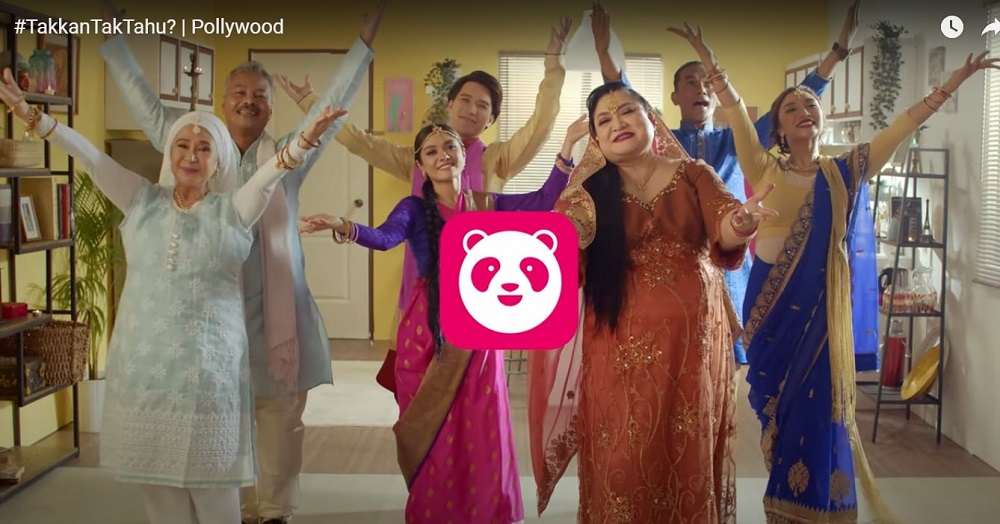KUALA LUMPUR, Oct 10 — So Foodpanda has had to apologise for their latest video which showed a cast of non-Indians in what looks like a Bollywood send-up.
It kicked up a row on social media as people accused Foodpanda of appropriating culture (by having non-Indians wear traditional Indian clothing) and/or whitewashing (having one race act like another).
Some people were especially angry as they thought it was a Deepavali ad (it wasn’t, Foodpanda explained) that did not even feature Indians.
Still, was this a case of racism (whether intended or not) or something else altogether? Malay Mail spoke to several advertising agency creatives to find out more.
Nina Mohamed-Nor, a freelance creative director and consultant, said that in the case of Foodpanda the creative team was probably banking on the popularity of the actors and influencers featured to fuel their message.
“Probably because no Indian actors or entertainers can match their huge following. Truth is, Indian entertainers are not given a platform to showcase their work. Occasionally, there will be a token Indian, Chinese or East Malaysian on the list for ‘Malaysian feels’,” she said.
Nina, who is also the former creative director at advertising agency BBDO, added that a decent strategic plan could have avoided such an outcome.
“Sometimes videographers, event companies and casting agencies may be banging on the doors of advertising agencies… baiting them with smaller budgets. The same people who don’t understand brand propositions, big ideas and corporate identities.
“A decent strategic plan takes into account the current climate and audience behaviour so this would never have happened. Seems like today, anyone can be an advertising ‘creative’ person,” she explained.
Zahir Mazlan, the Creative Group Head of VMLY&R Commerce, agrees with Nina but added that Foodpanda meant no ill-will and probably just wanted to pay tribute to the Malays’ love for Bollywood in a campaign to promote their show which targets Malays.
“If they would have asked a good media or strategic planner who has access to the calendar, they should’ve noticed that Deepavali is just around the corner and you can’t blame people for making that connection.
“Of course, the takeaway for us is to pay more attention to representation from day one, no matter what time of the year the ads come out,” he said.
Zahir also questioned how such an advertisement got past all the checkpoints before going out to the public.
“It is part and parcel of our challenging job to be aware of not just local, but international sentiments on social issues.
“Nowadays, it is not just about breaking through clutter and standing out, it is also making sure proper representation in our communications. Unless of course, being offensive is the goal,” he said.
He also shared that in the age of keyboard activism, some may view the Foodpanda advertisement as cultural appropriation.
However, he feels that it is not offensive.
“In this (Foodpanda) case, I do feel it is blown out of proportion. Whether it is intentional or not, I doubt they meant harm, because we (Malaysians) have been borrowing other culture’s costumes for ages with love and reverence.
“But of course, in the age of keyboard activism, some might see this as cultural appropriation especially since it doesn’t benefit the owners of the culture through the lack of consultation and representation. There are times when it was really clearly offensive but this is not it,” he said.
Chan Woei Hern, the Executive Creative Director at the same agency, said the nature of social media amplifies points-of-view, and when used right, can have a positive effect on the community.
“That’s the nature of social media isn’t it? Not necessarily just Malaysians. It amplifies points-of-view. We’ve seen it used to great effect, causing positive changes to communities.
“We’ve also seen it lead down a very dark misguided hole. As for advertising, if there are learnings, let’s take it and do better,” he said.
On representation and inclusivity of other races overall in advertising, Chan said the obvious marketing answer is finding talent that best reflects the majority of the customers.
“Can we do better as an industry to be more inclusive? Absolutely,” he said.
Zahir said that the dirty open secret is that most brands will not spend much money on a segment that they perceive will give low returns of investments, unless it is for brand-building or a festive campaign.
“If they do, they probably have the minorities as a token representation. Is this a horrible practice? Yes, it is. But I do hope this will change in the future and people keep speaking out about representation in advertising,” he said.
Nina said that minority groups in Malaysia have a hard time getting their fair share of the spotlight, hence becoming practically unknown.
“Even when they achieve international recognition through awards and achievements, it’s a single photo blurb, quickly forgotten the next day.
“Hurling insults in the guise of humour has been pretty much our gurau je attitude. However, they obviously don’t realise the emotional and mental repercussions that can follow,” she said.
Chan said that for advertising, it is always a double-edged sword.
“There are great examples of groundswell of support forcing brands to reflect and behave in a better way. There are also examples where popular sentiment actually dampens efforts for brands to be brave.
“Great example is the Libresse Kebaya pack design that got ‘cancelled.’ I want to give a shout out to the clients and agency for that campaign, because the groundswell of support was just as powerful,” he said, referring to the vulva imagery incorporated into the pack design of Libresse sanitary pads.



















